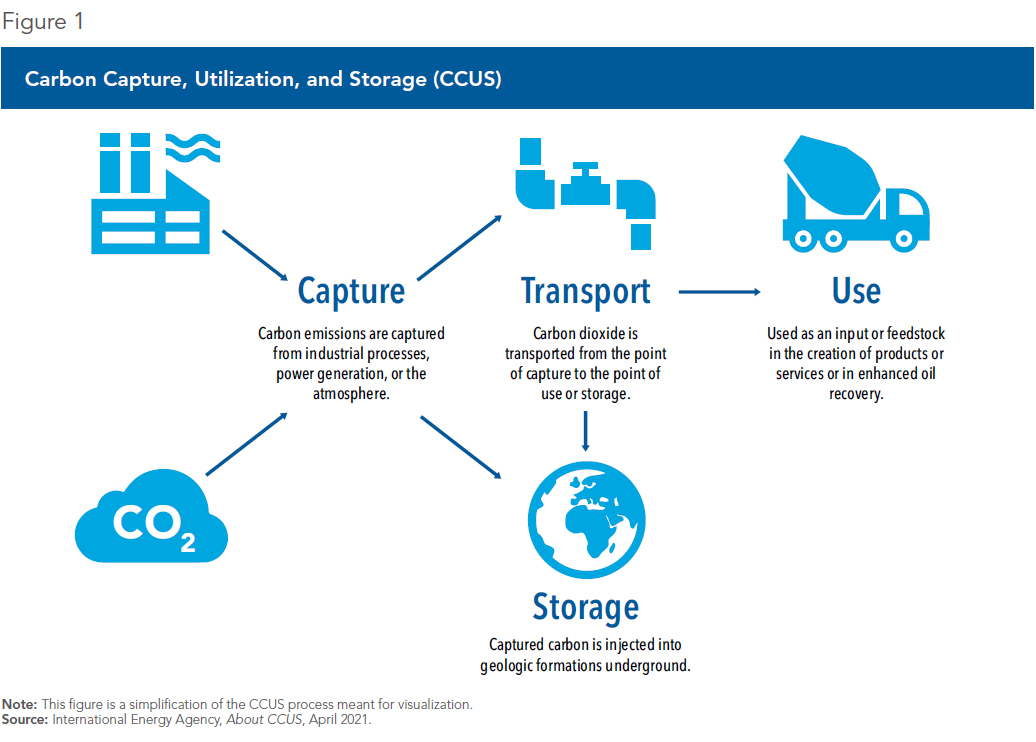Carbon Capture, Utilization, and Storage: An Entrepreneurial Approach to Reducing GHG Emissions

Viewpoint on how CCUS can help balance the need to protect the environment with the importance of energy to the economy and to the standard of living of Canadian families
With GHG emission reduction targets getting ever more ambitious, and the pressing need for concrete results, the technological tools at our disposal keep improving. This publication looks at CO2 capture, utilization, and storage/sequestration (CCUS) technologies, which are playing a bigger and bigger role and could allow us to reach our targets without compromising our standard of living.
 Related Content
Related Content
 |
 |
 |
| Interview (in French) with Miguel Ouellette (Mario Dumont, QUB Radio, October 14, 2021) |
This Viewpoint was prepared by Krystle Wittevrongel, Public Policy Analyst at the MEI, in collaboration with Miguel Ouellette, Director of Operations and Economist at the MEI. The MEI’s Environment Series aims to explore the economic aspects of policies designed to protect the natural world in order to encourage the most cost-effective responses to our environmental challenges.
The global effort to reduce greenhouse gas emissions is in the news again. In late September 2021, the UN’s High-Level Dialogue on Energy affirmed commitments from dozens of governments to achieve sustainable energy and carbon neutrality goals.(1) In addition, the UN Climate Change Conference (COP26) is just around the corner, with a doubling down on climate commitments expected.(2) If countries indeed decide to move forward with more ambitious reductions targets, it will be even more important for policy-makers to choose the most efficient environmental policies.
In particular, as the world builds toward a low-carbon future, the merits of carbon capture, utilization, and storage/sequestration (CCUS) are becoming more apparent. These technologies can play a significant role in balancing the need to protect the environment with the importance of energy to the Canadian economy and to the standard of living of Canadian families. Indeed, the federal government has identified CCUS not only as an important tool for reducing emissions, but as the only technology currently available with the potential to generate negative emissions.(3) But in order for energy entrepreneurs to propel us in the direction of Canada’s climate change goals, a robust self-sustaining market for CCUS must emerge.
What Is CCUS?
CCUS encompasses technologies to capture carbon emitted during power generation and industrial processes, thereby preventing its release into the environment. These technologies can also capture carbon already emitted into the atmosphere, thus reducing overall accumulation.(4)
When trapped at the source, carbon emissions are separated from other gases produced industrially at facilities such as power plants, steel mills, and oil and gas refineries. If not used on-site, these emissions are transported, often by pipeline, for use elsewhere (such as in concrete or in the production of synthetic fuels, among others)(5) or injected into geological formations for permanent storage(6) (see Figure 1). In fact, the same formations from which oil and gas are extracted can store CO2, deep in the ground.(7)

Although most CCUS technologies can absorb around 85% to 95% of CO2 produced by a power plant, there is an energy efficiency penalty in the additional energy requirements necessary to operate the facilities.(8) However, even with increased energy requirements, CCUS technologies have been reported to support an overall atmospheric reduction of more than 85%,(9) with some projects at 90%(10) and even 100%.(11)
CCUS and Net-Zero
Alongside over 120 other countries, Canada has pledged to achieve net-zero emissions by 2050.(12) In order to do so, the Canadian economy needs to either emit virtually no GHGs or find some other way to offset emissions. While significant improvements have been made in energy efficiency, there are still high-emitting industries such as steel and cement that lack viable options for reducing emissions.(13) Therefore, in order to achieve emissions reductions of the magnitude necessary to reach net-zero, we will need to employ technologies that can capture carbon. Not only can we not achieve carbon neutrality without them, but trying to do so would have harmful impacts on our economic growth, greatly compromising our standard of living.
CCUS fits into the broader circular economy model for mitigating emissions. The four Rs of the circular carbon economy—reduce, reuse, recycle, and remove—were endorsed at the G20 Energy Ministers meeting in 2020 as being “a holistic, integrated, inclusive, and pragmatic approach to managing emissions.”(14) As such, CCUS has a part to play in a resilient, sustainable system. The federal government has acknowledged that CCUS is a significant opportunity for Canada, not only in terms of our climate change agenda, but also in terms of economic opportunities.(15) Energy entrepreneurs also recognize the opportunities that CCUS represents, both for the industry and for the environment.(16)
Canada’s CCUS Potential
In recent years, some of the world’s largest and most advanced carbon capture projects have been developed in Western Canada.(17) Canada’s four existing projects represent 15% of global facilities, and currently capture 4 million tonnes of carbon emissions annually, with two additional massive carbon capture hubs in the works.(18) With abundant geological storage for permanent sequestration, as well as industry expertise and technical capacity, Canada has the potential to become a real leader in CCUS.(19)
However, challenges remain, such as high front-end costs, and in order to enable and grow commercial CCUS, government mechanisms need to incentivize entrepreneurs to do what they do best: innovate. That does not mean picking winners and losers or favouring particular industry players. But these cutting-edge technologies require large-scale deployment to meet climate change mitigation targets, and that can’t be achieved without the active involvement of the private sector.
Currently, many measures in Canada’s climate change strategy come with uncertainties, competitive disadvantages, and job losses for manufacturing and other sectors.(20) In contrast, well-designed measures to incentivize the capture and utilization or storage of carbon emissions could be less costly overall, while still helping to achieve Canada’s climate goals. The federal government should carefully consider the development and implementation of the measures it adopts to make sure they are as efficient as possible.
References
- International Institute for Sustainable Development, Highlights and images of main proceedings for 24 September 2021, consulted September 30, 2021.
- UN Climate Change Conference UK 2021, “COP26 Explained,” 2021, p. 9.
- Government of Canada, Budget 2021: A Recovery Plan for Jobs, Growth, and Resilience, April 19, 2021, p. 167.
- International Energy Agency, About CCUS, April 2021.
- David Roberts, “These uses of CO2 could cut emissions – and make trillions of dollars,” Vox, November 27, 2019.
- International Energy Agency, op. cit., endnote 4.
- Government of Canada, “Oil Sands: A strategic resource for Canada, North America and the global market,” Natural Resources Canada, May 2016, p. 1.
- Tabbi Wilberforce et al., “Progress in carbon capture technologies,” Science of the Total Environment, Vol. 761, March 20, 2021, p. 2.
- Mohamed Kanniche et al., “Pre-combustion, post-combustion and oxy-combustion in thermal power plant for CO2 capture,” Applied Thermal Engineering, Vol. 30, No. 1, January 2010, p. 57.
- NRG, Case Studies, Petra Nova, Carbon capture and the future of coal power, 2021, consulted September 30, 2021; Center for Climate and Energy Solutions, Climate Solutions, Technology Solutions, Carbon Capture, consulted September 30, 2021.
- James Conca, “Net Zero Natural Gas Plant – The Game Changer,” Forbes, July 31, 2019.
- Government of Canada, Environment and natural resources, Climate change, Canada’s climate plan, Net-Zero Emissions by 2050, August 13, 2021.
- Chris Bataille, Low and zero emissions in the steel and cement industries, Issue Paper, OECD, November 26 & 27, 2019, p. 13.
- G20 Research Group, “G20 Energy Ministerial Meeting,” Communique, September 28, 2020, p. 2.
- Government of Canada, Natural Resources Canada, Climate Change, Canada’s green future, Carbon capture, utilization and storage strategy, September 7, 2021.
- Suncor Energy Inc., “Canada’s largest oil sands producers announce unprecedented alliance to achieve net zero greenhouse gas emissions,” Press release, June 9, 2021.
- David Coglon, “Canada’s carbon tech opportunity,” Context: Energy Examined, Canadian Association of Petroleum Producers, March 2, 2021.
- Rod Nickel and Nia Williams, “Canada pushes to build 2 new carbon capture hubs – gov’t document,” Reuters, August 30, 2021.
- International CCS Knowledge Centre, “Canada’s Budget 2021: Carbon Capture & Storage,” April 29, 2021.
- Miguel Ouellette, “The CFS: A Measure That Will Hurt Canada’s Economic Recovery,” Economic Note, MEI, September 17, 2020.

